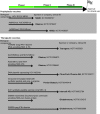Progress towards a hepatitis C virus vaccine
- PMID: 26038445
- PMCID: PMC3924556
- DOI: 10.1038/emi.2013.79
Progress towards a hepatitis C virus vaccine
Abstract
New drugs to treat hepatitis C are expected to be approved over the next few years which promise to cure nearly all patients. However, due to issues of expected drug resistance, suboptimal activity against diverse hepatitis C virus (HCV) genotypes and especially because of their extremely high cost, it is unlikely that these HCV drugs will substantially reduce the world's HCV carrier population of around 170 million in the near future or the estimated global incidence of millions of new HCV infections. For these reasons, there is an urgent need to develop a prophylactic HCV vaccine and also to determine if therapeutic vaccines can aid in the treatment of chronically infected patients. After much early pessimism on the prospects for an effective prophylactic HCV vaccine, our recent knowledge of immune correlates of protection combined with the demonstrated immunogenicity and protective animal efficacies of various HCV vaccine candidates now allows for realistic optimism. This review summarizes the current rationale and status of clinical and experimental HCV vaccine candidates based on the elicitation of cross-neutralizing antibodies and broad cellular immune responses to this highly diverse virus.
Keywords: HCV; hepatitis; infection; prophylactic; therapeutic; vaccine.
Figures



Similar articles
-
Progress toward approval of an HCV vaccine.Can Liver J. 2018 Oct 3;1(3):130-138. doi: 10.3138/canlivj.2018.0010. eCollection 2018 Summer. Can Liver J. 2018. PMID: 35991323 Free PMC article. Review.
-
Methods to Evaluate Novel Hepatitis C Virus Vaccines.Methods Mol Biol. 2016;1403:221-44. doi: 10.1007/978-1-4939-3387-7_11. Methods Mol Biol. 2016. PMID: 27076133
-
Advances in hepatitis C virus vaccines, Part one: Advances in basic knowledge for hepatitis C virus vaccine design.Expert Opin Ther Pat. 2011 Dec;21(12):1811-30. doi: 10.1517/13543776.2011.630662. Epub 2011 Oct 25. Expert Opin Ther Pat. 2011. PMID: 22022980 Review.
-
Therapeutic vaccination against chronic hepatitis C virus infection.Antiviral Res. 2012 Oct;96(1):36-50. doi: 10.1016/j.antiviral.2012.07.006. Epub 2012 Jul 25. Antiviral Res. 2012. PMID: 22841700 Review.
-
Development of a heterologous, multigenotype vaccine against hepatitis C virus infection.Eur J Clin Invest. 2007 May;37(5):396-406. doi: 10.1111/j.1365-2362.2007.01802.x. Eur J Clin Invest. 2007. PMID: 17461986
Cited by
-
Burden of viral hepatitis caused by specific aetiologies in China, 1990-2016: findings from the GBD 2016.BMC Public Health. 2020 Sep 29;20(1):1461. doi: 10.1186/s12889-020-09533-4. BMC Public Health. 2020. PMID: 32993585 Free PMC article.
-
Exploring NS3/4A, NS5A and NS5B proteins to design conserved subunit multi-epitope vaccine against HCV utilizing immunoinformatics approaches.Sci Rep. 2018 Oct 31;8(1):16107. doi: 10.1038/s41598-018-34254-5. Sci Rep. 2018. PMID: 30382118 Free PMC article.
-
A Novel Adeno-Associated Virus-Based Genetic Vaccine Encoding the Hepatitis C Virus NS3/4 Protein Exhibits Immunogenic Properties in Mice Superior to Those of an NS3-Protein-Based Vaccine.PLoS One. 2015 Nov 10;10(11):e0142349. doi: 10.1371/journal.pone.0142349. eCollection 2015. PLoS One. 2015. PMID: 26556235 Free PMC article.
-
Single-Genome Sequencing of Hepatitis C Virus in Donor-Recipient Pairs Distinguishes Modes and Models of Virus Transmission and Early Diversification.J Virol. 2015 Oct 14;90(1):152-66. doi: 10.1128/JVI.02156-15. Print 2016 Jan 1. J Virol. 2015. PMID: 26468546 Free PMC article.
-
Indole - a promising pharmacophore in recent antiviral drug discovery.RSC Med Chem. 2020 Nov 6;11(12):1335-1353. doi: 10.1039/d0md00288g. eCollection 2020 Dec 17. RSC Med Chem. 2020. PMID: 34095843 Free PMC article. Review.
References
-
- Choo QL, Kuo G, Weiner AJ, Overby LR, Bradley DW, Houghton M. Isolation of a cDNA clone derived from a blood-borne non-A, non-B viral hepatitis genome. Science. 1989;244:359–362. - PubMed
-
- Ciesek S, Manns MP. Hepatitis in 2010: the dawn of a new era in HCV therapy. Nat Rev Gastroenterol Hepatol. 2011;8:69–71. - PubMed
-
- Chatel-Chaix L, Germain MA, Gotte M, Lamarre D. Direct-acting and host-targeting HCV inhibitors: current and future directions. Curr Opin Virol. 2012;2:588–598. - PubMed
-
- Tanaka Y, Nishida N, Sugiyama M, et al. Genome-wide association of IL28B with response to pegylated interferon-alpha and ribavirin therapy for chronic hepatitis C. Nat Genet. 2009;41:1105–1109. - PubMed
-
- Ge D, Fellay J, Thompson AJ, et al. Genetic variation in IL28B predicts hepatitis C treatment-induced viral clearance. Nature. 2009;461:399–401. - PubMed
Publication types
LinkOut - more resources
Full Text Sources
Other Literature Sources
